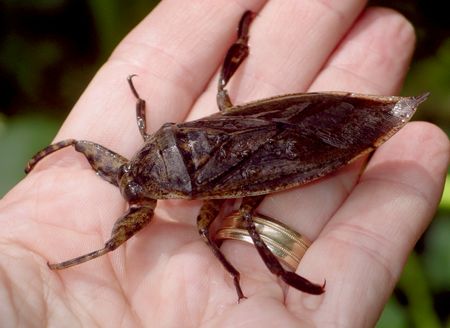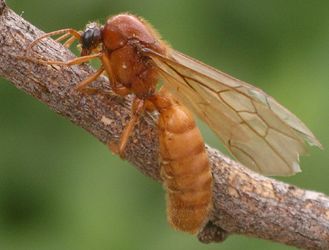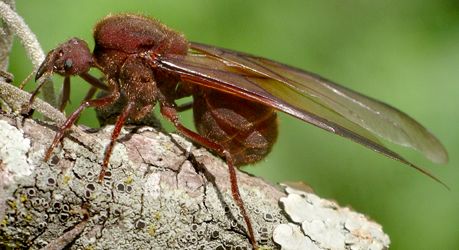 giant red-headed centipede |
As mammals, we are sort of an average size. Certainly not when compared to the largest members of this class, such as hippos, elephants and blue whales, but it is obvious that the vast majority, including rodents, bats, and shrews, are a whole lot tinier. Taking all vertebrates into account, there are relatively few that outweigh us. Ostriches, saltwater crocodiles, and great white sharks notwithstanding, we feel secure in our superior mass when it comes to encounters with frogs, minnows, and songbirds. There are also relatively few invertebrates that are big enough to beat us in a wrestling match. Most people are unlikely to encounter a giant squid; and terrestrial spineless creatures are definitely gravity-challenged. When it comes to arthropods, the largest is still small enough to crush under our size 10, or even 7, shoes.
 giant red-headed centipede |
One reason for overreaction to insects is that they are so unlike us. They have too many legs and other appendages, wear their skeleton on the outside, and, well, just look rather alien. I receive a fair number of arthropod identification requests from people, so I have a pretty good idea of how the general public perceives insects and spiders. First, folks are terrible at describing these animals, so a photo is almost a necessity. Second, their immediate impression almost always includes the most venomous or notorious possibility, sometimes not even closely related to what they actually saw. And third, and this is very consistent, the size of any arthropod is usually doubled.
 giant water bug |
It's understandable that wings and long legs can be deceiving, especially when the animal is moving about or in a low light situation. It also makes sense that the closer the encounter, the bigger the appearance. A tarantula, our largest spider here in Texas, is big when seen on a road, massive when found on a sidewalk, and absolutely gigantic when seen in a backyard shed. People tell me of the four inch long spiders they see. They will even insist on this length when told that the legs don't count. In reality, most tarantulas seen wandering are males, which are smaller than the females. Even a large female will rarely reach two inches from fangs to spinnerets.
The wingspan of moths and butterflies is the exception to the rule of using just body measurement when describing an insect. Lepidopteran bodies are so small in relation to their wings that it is useless to try to gauge their length. And some of our largest butterflies can be truly impressive. For an insect, a four-inch wingspan is eye-catching.
In spite of the fact that insects are, indeed, much smaller than us, in terms of relative comparisons, there are some giants among them. For any particular group, the biggest is noteworthy. People used to seeing the ordinary white grubs that they dig up in their gardens can't help but be amazed at the size of the similar looking creatures they find in their compost that will literally cover the palm of a human hand. The smaller white grubs turn into your average brown 5/8 inch long June beetle. The monster in the compost, after eating dead wood for two or three years, becomes an ox beetle, which can be over twice as large. We come across so many tiny ladybugs, house flies, mosquitoes, pillbugs, and inchworms that any arthropod larger than a honey bee is startling.
Many different taxons have their prize-winners. Stick insects, or walkingsticks, are normally about two inches long and very slender. The giant walkingstick, though, which is not uncommon in our area, can reach a length of six inches, and it is a hefty bug. When one falls from an oak tree, it is not easily missed! A native Texas species, the giant red-headed centipede is another show-stopping beast. Most centipedes are under two inches long, but this one not only tops six inches but also has crazy colors to warn predators of its venomous nature. Rain storms on warm summer nights will often cause our largest true bug to fly to lights. The giant water bug is not only about two inches long, but it can also deliver a painful bite if it feels threatened.
The most alarming large insects are those that are not often seen. Perhaps the least likely to be found, but certainly not an uncommon animal, is the queen of a termite colony. These legendary insects are many times the size of their workers but they live their long lives deep within the subterranean nest, producing multitudes of eggs and being attended to by their progeny.
While unrelated to termites, ants also have queens and sometimes form huge colonies. When conditions are right, such as after rain and warm weather, hordes of alates (the winged males and females that will start new colonies) emerge from the nest to mate and disperse. For most kinds of ants, the alates are not a whole lot bigger than the workers, but there are exceptions. One kind of male alate is so distinctive that it has its own name: sausage fly. This is the legionary ant, a type of army ant. The workers are small and hardly ever noticed, and the large queens are wingless and so stay hidden. Only the males travel in search of mates; they look a lot like strange wasps, which is no surprise as ants are closely related to that group.
 sausage fly |  Texas leafcutter ant queen |
While they don't come close to the size of fossil species (which could sport wingspans of two feet or more), there are still a number of extant insects that warrant the moniker "giant." We vertebrates are fortunate indeed that the physiology of arthropods in Earth's environment precludes their growing to spectacular sizes. We can certainly imagine what it might be like to be dwarfed by insects or spiders, but luckily, in spite of the best efforts by the motion picture industry, we never have to experience it as reality.